Continuing the virtual tour of historic murals in area towns, today we go to southern Mercer County, to the town of Fort Recovery.
Fort Recovery has a number of historic murals that show important events of the town’s past. And there is a lot of history in this town.
The first mural welcomes visitors coming from the north, at 220 Wayne Street, Welcome to Historic Fort Recovery.
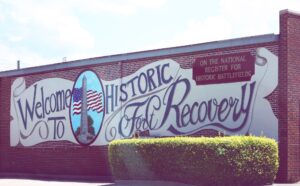
Welcome to Historic Fort Recovery. (2025 photo by Karen)
Two historic murals face each other and flank Fort Recovery Historical Museum and Krenning Park, on the west side of Wayne Street. These two murals memorialize two well-known battles fought there, St. Clair’s Defeat, aka the Battle of the Wabash, in 1791, and the Victory of Anthony Wayne, aka the Battle of Fort Recovery, in 1794. Both murals were painted by the late Dan Keyes, of New Bremen.
To the south is the mural of Arthur St. Clair’s Defeat:
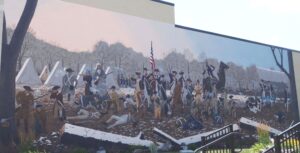
St. Clair’s Defeat, Fort Recovery, Ohio, whole mural. (2025 photo by Karen)
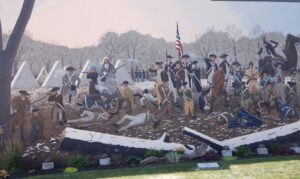
Left side of St. Clair’s Defeat, Fort Recovery, Ohio. (2025 photo by Karen)
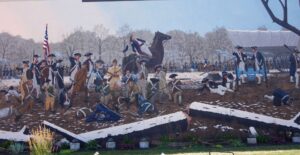
Right side of St. Clair’s Defeat, Fort Recovery, Ohio. (2025 photo by Karen)
On 4 November 1791, General Arthur St. Clair and his army were defeated by the Northwestern Confederacy of Native Americans, nine tribes lead by Little Turtle of the Miamis, Blue Jacket of the Shawnees, and Buckongahelas of the Delawares. Over 1400 Native Americans defeated St. Clair’s army. Over 650 American soldiers were killed as well as several hundred camp followers. It was the worst U.S. military defeat in the country’s history, and two thirds of the U.S. Army were killed or missing.
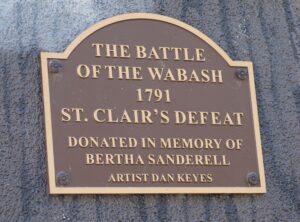
Plaque by St. Clair’s Defeat mural, Fort Recovery, Ohio. (2025 photo by Karen)
To the north is the mural of Anthony Wayne’s Victory/The Battle of Fort Recovery:
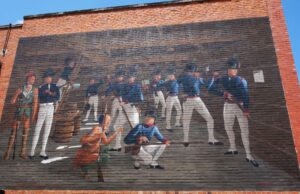
Anthony Wayne’s Victory, Fort Recovery, Ohio. (2025 photo by Karen)
After St. Clair’s defeat, General Anthony Wayne was appointed commander of the U.S. Army and in 1793 Fort Recovery was built at the site of St. Clair’s defeat. On 30 June 1794, the combined Native American forces attacked the fort but gave up their strike after a two-day battle. That victory and the victory at Fallen Timbers led to the signing of the Treaty of Greenville in 1795. The treaty opened the Ohio Country for peaceful settlement and Ohio became a state in 1803.
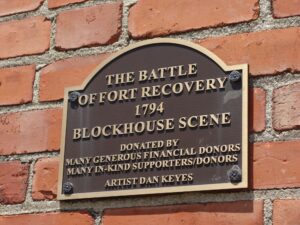
Anthony Wayne’s Victory/The Battle of Fort Recovery, Fort Recovery, Ohio. (2025 photo by Karen)
The battlefield is a short walk away.
A block south, on the corner of Butler and Wayne Streets, a mural features the 1913 Fort Recovery Jubilee, also painted by Dan Keyes. At one time Fort Recovery held their jubilee on Wayne Street. As the mural depicts, there were trapeze artists, a balloon ascension, a Ferris wheel, and a cannon that fired to alert the crowd of a midway event.
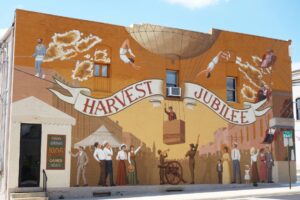
Harvest Jubilee, Fort Recovery, Ohio. (2025 photo by Karen)
A couple blocks north, on the corner of Wayne and East Boundary Streets, a mural covers the entire north side of the building. This painting looks like three large postage stamps featuring vintage local businesses, the Fort Recovery Stirrup Company, the Lake Erie & Western Railroad, and Ranly Brothers. A man in a bi-plane flies above them.
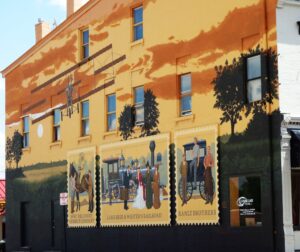
Vintage Fort Recovery businesses. (2025 photo by Karen)
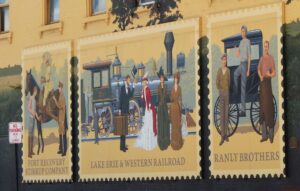
Vintage Fort Recovery businesses. (2025 photo by Karen)
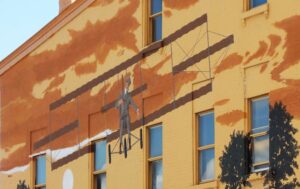
Man in a bi-plane, Fort Recovery. (2025 photo by Karen)
The goal of these murals was to “enhance the historic aura of our town and ultimately increase the visitors who come and learn more about our significant place in history.
They certainly do that.


2 comments
These are awesome murals. Thanks for sharing.
Author
Yes, they are beautiful. The whole downtown area looks very nice, too, and the murals add a nice touch. Thanks for writing.